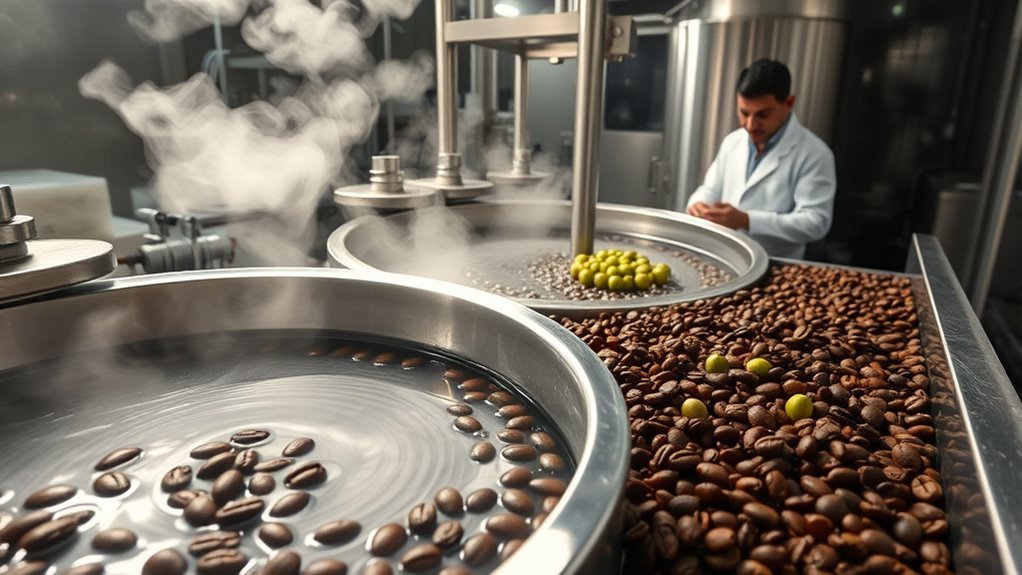How Is Decaf Coffee Made? a Guide to the Different Processes
Decaf coffee is made by removing up to 97% of caffeine from green beans through precise methods. You can choose the Swiss Water Process, which uses only water to maintain flavor without chemicals. Alternatively, the CO2 method employs pressurized carbon dioxide to selectively extract caffeine, preserving complexity. Chemical solvents like methylene chloride and ethyl acetate target caffeine but require strict regulation. Each technique impacts flavor and health differently, influencing your ideal decaf choice—explore these nuances to understand them fully.
Understanding the Need for Decaffeination

Why do people choose decaf coffee despite the rich flavor and stimulating effects of regular coffee? The answer lies primarily in individual caffeine sensitivity and the growing decaf popularity among those seeking control over their intake. If you’re sensitive to caffeine, consuming regular coffee can lead to adverse effects such as insomnia, increased heart rate, or anxiety. Decaffeination offers a technical solution, removing most caffeine while preserving the coffee’s characteristic flavor profile. This process grants you the freedom to enjoy coffee without sacrificing your well-being or daily routine. As awareness of caffeine’s impact grows, so does the demand for decaf options, reflecting a shift toward personalized consumption choices that prioritize health without compromising on taste or experience.
The Swiss Water Process Explained
You’ll find the Swiss Water Process uses only water to extract caffeine, eliminating the need for chemicals. This method relies on solubility and osmosis to selectively remove caffeine molecules while retaining other compounds responsible for flavor. Understanding this process clarifies how decaf coffee can maintain its original taste profile despite caffeine removal.
Chemical-Free Decaffeination Method
Although many decaffeination methods rely on chemical solvents, the Swiss Water Process offers a chemical-free alternative that uses only water, temperature, and time to extract caffeine from coffee beans. This method employs a carefully controlled solution called Green Coffee Extract (GCE), saturated with coffee solubles but free of caffeine. When beans are immersed, caffeine diffuses into the GCE while flavor compounds remain. This natural alternative debunks common decaf myths suggesting all decaffeination involves harsh chemicals. By avoiding solvents, you retain a purer product, aligning with your desire for freedom from additives. The process is meticulous—water temperature, flow rate, and exposure time are precisely managed to guarantee efficient caffeine removal. This technique exemplifies how scientific rigor and natural alternatives can coexist to deliver chemical-free decaf coffee.
How Flavor Is Preserved
Since the Swiss Water Process relies on a carefully balanced Green Coffee Extract saturated with coffee solubles but caffeine-free, it preserves flavor by preventing the loss of key taste compounds during decaffeination. You benefit from exceptional flavor retention because this method exploits solubility equilibrium, selectively removing caffeine molecules while maintaining soluble aromatic compounds. Aroma preservation is achieved as the extract’s precise composition guarantees volatile oils and phenolic compounds remain intact. Unlike chemical solvents that indiscriminately strip flavor elements, the Swiss Water Process uses water and osmosis principles, offering you a decaffeinated coffee that closely mirrors the original sensory profile. This technique empowers you with a cup that retains complexity and depth, meeting your desire for freedom from additives without compromising the nuanced character of your brew.
How the CO2 Method Works
When extracting caffeine from coffee beans, the CO2 method leverages the unique solvent properties of carbon dioxide under high pressure. In this process, liquid CO2 acts selectively on caffeine molecules, dissolving them without stripping away essential flavor compounds. You place green coffee beans in an extraction vessel where CO2 is pressurized to around 300 atmospheres, enabling it to penetrate the beans and bind caffeine efficiently. After absorption, the caffeine-rich CO2 moves to a separate chamber where pressure is reduced, releasing the caffeine for collection. This cycle preserves the coffee’s integrity, maintaining the aromatic profile you value. The CO2 extraction offers notable decaf benefits: it’s chemical-free, environmentally friendly, and precise, granting you freedom to enjoy decaf coffee that closely resembles its original character.
The Role of Solvents in Decaffeination
You’ll find that common solvents like methylene chloride and ethyl acetate are widely used to extract caffeine efficiently. Understanding the stringent safety measures guarantees these solvents don’t leave harmful residues in your coffee. Additionally, the choice of solvent can subtly influence the final flavor profile, affecting your overall tasting experience.
Common Solvent Types
Although the decaffeination process can employ various methods, solvents play a crucial role in selectively extracting caffeine from coffee beans without compromising flavor compounds. The common solvent types used include methylene chloride, ethyl acetate, and supercritical carbon dioxide. Each solvent type targets caffeine molecules with high specificity, enabling efficient caffeine extraction while preserving the beans’ essential oils and aromatic constituents. Methylene chloride and ethyl acetate are organic solvents known for their caffeine affinity and relatively low boiling points, facilitating easy removal post-extraction. Meanwhile, supercritical carbon dioxide acts as a tunable solvent, penetrating beans deeply and dissolving caffeine under controlled temperature and pressure. Understanding these solvent types empowers you to appreciate how decaffeination balances chemical precision with flavor integrity, allowing you to enjoy coffee freedom without sacrificing taste.
Solvent Safety Measures
Understanding the solvents involved in decaffeination naturally leads to concerns about their safety. You’ll want to know that strict solvent regulations govern the entire process, ensuring residual solvent levels in coffee beans remain well below harmful thresholds. These regulations are enforced by agencies like the FDA and EFSA, which mandate thorough testing throughout production. Safety standards require solvents to be food-grade and removed efficiently after caffeine extraction. You can trust that the processes incorporate multiple solvent recovery steps, minimizing residue. Additionally, analytical techniques such as gas chromatography verify compliance with these standards before beans reach consumers. By adhering to solvent regulations and rigorous safety standards, decaffeination maintains both your health and freedom to enjoy coffee without compromising quality or safety.
Impact on Coffee Flavor
While solvents play an essential role in removing caffeine from coffee beans, their impact on the coffee’s flavor profile is a key consideration for both producers and consumers. You’ll find that solvents like methylene chloride and ethyl acetate selectively target caffeine molecules while aiming to preserve the beans’ intrinsic flavor compounds. However, slight alterations in the flavor profile can occur, sometimes leading to muted or altered aromatic notes. Maintaining taste consistency across batches requires precise control of solvent exposure time and temperature. If these parameters aren’t carefully managed, you might notice variability in acidity, body, or sweetness. Ultimately, solvent-based decaffeination balances effective caffeine removal with preserving the coffee’s original character so you can enjoy decaf without sacrificing flavor integrity.
Comparing Chemical Solvent Techniques

When you examine chemical solvent techniques for decaffeination, you’ll find that they primarily rely on selective extraction processes using compounds like methylene chloride or ethyl acetate. Understanding the nuances of these chemical solvents is essential in any decaf comparison.
- Methylene Chloride: Highly effective at targeting caffeine, it leaves minimal residue due to its low boiling point.
- Ethyl Acetate: Often marketed as “natural,” derived from fruit, but chemically similar in extraction efficiency.
- Process Conditions: Both techniques require precise temperature and pressure control to avoid damaging coffee beans.
- Solvent Removal: Rigorous post-extraction steps guarantee solvents are reduced to safe, trace levels.
The Impact of Decaffeination on Flavor
Because decaffeination alters the chemical composition of coffee beans, it inevitably affects flavor compounds you expect in a cup. The balance of decaf flavor profiles depends on the method used, influencing aroma retention and overall sensory experience. You’ll notice subtle shifts — some processes preserve more oils and acids, others diminish complexity.
| Decaf Method | Aroma Retention | Flavor Characteristics |
|---|---|---|
| Swiss Water | High | Bright, slightly fruity |
| Chemical Solvent | Moderate | Milder, sometimes flat |
| CO2 Process | Very High | Full-bodied, complex |
| Triglyceride | Moderate to High | Smooth, balanced, nutty notes |
Choose decaf with a method that aligns with your flavor freedom preferences.
Health Considerations With Different Decaf Methods
Although decaffeination effectively reduces caffeine content, the choice of method can influence the presence of residual solvents, potential chemical byproducts, and nutrient retention in your coffee. When selecting decaf, consider these health-related factors:
- Solvent Residues: Chemical methods like methylene chloride or ethyl acetate might leave trace solvents, posing minimal but notable health risks for sensitive individuals.
- Chemical Byproducts: Some processes generate byproducts that could affect your body’s response, especially if you have caffeine sensitivity or allergies.
- Nutrient Retention: Water-based and CO2 methods generally preserve antioxidants better, supporting your health more effectively.
- Caffeine Sensitivity: Even decaf contains small caffeine amounts; your sensitivity level dictates tolerance and potential side effects.
Understanding these nuances helps you choose a decaf process that aligns with your health priorities and desire for freedom from adverse effects.
Environmental Effects of Decaf Coffee Processing

Beyond health considerations, the methods used for decaffeination also carry significant environmental implications. When you evaluate decaf coffee processing, sustainability concerns arise primarily from water usage, chemical solvents, and energy consumption. For example, the Swiss Water Process, though chemical-free, requires substantial water and energy, increasing its environmental impact. Conversely, solvent-based methods often rely on chemicals that, if not managed properly, can contaminate ecosystems. You should also consider the carbon footprint associated with each method’s energy demands. The environmental impact isn’t uniform; it varies depending on the scale and efficiency of the process. By understanding these factors, you can better assess which decaffeination approach aligns with your values on ecological responsibility and sustainability, ultimately influencing your freedom to choose a product with reduced environmental costs.
Choosing the Right Decaf Coffee for You
How do you determine which decaf coffee suits your preferences and values best? Selecting the ideal decaf involves analyzing decaf varieties and their distinct flavor profiles. Consider these four factors:
- Decaffeination Method: Choose between chemical, Swiss Water, or CO2 processes, each impacting flavor and chemical residue differently.
- Origin of Beans: Regional sources influence inherent flavor profiles—Central American beans tend to be bright, while Indonesian ones offer earthier notes.
- Roast Level: Light roasts preserve origin characteristics, while darker roasts emphasize bolder, caramelized flavors, affecting your sensory experience.
- Certifications and Sustainability: Look for organic or fair-trade labels if environmental and ethical considerations align with your values.
Frequently Asked Questions
Can Decaf Coffee Still Cause Insomnia or Jitters?
Yes, decaf coffee can still cause insomnia or jitters if you have high caffeine sensitivity, since it contains small caffeine amounts. Your sleep quality might be affected, especially if you consume decaf late in the day or in large quantities. While decaf reduces caffeine intake, it doesn’t eliminate it entirely, so you should monitor your body’s reactions. Adjusting consumption based on your sensitivity can help maintain better sleep quality and avoid unwanted jitters.
How Long Does Decaf Coffee Stay Fresh After Brewing?
Like a candle flickering in the wind, decaf coffee’s freshness is fleeting after brewing. You’ve got to take into account freshness factors such as exposure to air, heat, and light, which degrade flavor rapidly. Depending on brewing methods, your decaf stays ideal for about 30 minutes to an hour. To savor true flavor freedom, drink it soon or store it in an airtight container, but avoid reheating—it compromises taste and aroma.
Does Decaf Coffee Contain Antioxidants Like Regular Coffee?
Yes, decaf coffee does contain antioxidants like regular coffee, though its antioxidant levels are slightly lower due to the decaffeination process. You’ll still enjoy many decaf benefits, including protection against oxidative stress and inflammation. While caffeine is reduced, key antioxidant compounds such as chlorogenic acids remain present, offering health advantages. So, if you want freedom from caffeine but still desire antioxidant intake, decaf is a viable option.
Is Decaf Coffee More Expensive Than Regular Coffee?
You might be surprised to learn that decaf pricing often exceeds regular coffee costs. This stems from the intricate processes required to remove caffeine while preserving coffee quality. These methods demand specialized equipment and additional labor, which drive prices up. So, if you crave freedom from caffeine without sacrificing flavor, expect to invest a bit more. The added cost reflects the technical precision needed to maintain the coffee’s essence in decaf form.
Can You Make Decaf Coffee at Home Without Special Equipment?
You can’t truly decaffeinate coffee at home without specialized equipment due to the complex chemical processes involved. However, with home brewing, you can experiment with DIY methods like blending a small amount of decaf beans with regular ones to reduce caffeine intake. While not pure decaf, this approach offers freedom to customize caffeine levels. For genuine decaf, commercially processed beans remain your best option, as effective caffeine removal requires industrial-grade solvents or water methods.






